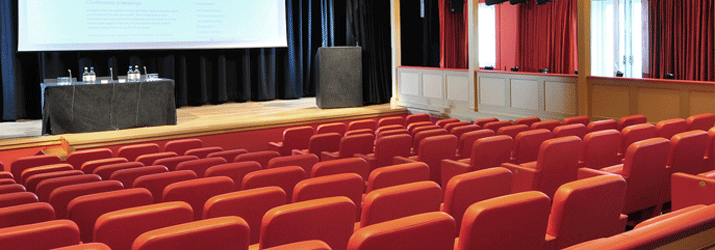
The inaugural ABN Movement Disorders Special Interest Group (ABN MD SIG) meeting took place on the 15th and 16th of January 2015 at Downing College, Cambridge. The programme was organised by Professor David Burn (Newcastle) and Dr Paul Worth (Cambridge) and included several internationally renowned speakers.
The ABN MD SIG is the new name for the British and Irish Neurologists Group for Movement Disorders (BRING-MD). The ABN MD SIG is affiliated with the ABN.
The meeting opened with the keynote lecture by Professor Andrew Lees of Queen Square, titled ‘Hanging out with the molecules’, in which he discussed his early career, in particular his research and successes with dopaminergic therapy in Parkinson’s disease and his fundamental role in the institution of apomorphine treatment in patients with frequent ‘off’ periods.
To inspire delegates before we embarked on an intensive day of talks, Chris Moon MBE delivered a motivational speech. He is a distinguished ex-soldier, whom amongst his many noteworthy experiences was captured by the Khmer Rouge (and negotiated his own release), cleared landmines in Africa (during which time he was unfortunately significantly injured) and now with a prosthetic leg and arm runs ultra marathons.
The morning session aimed to summarise current topics that have furthered our understanding in the pathophysiology of movement disorders.
Professor Tony Schapira enlightened us on how GBA1 gene mutations (encoding a ubiquitous lysosomal enzyme glucocerebrosidase,GBA) have provided further insights into the pathogenesis of Parkinson’s disease (PD). Around 7 to 10% of PD patients have GBA1 mutations and studies of GBA1 mutation cohorts which found higher RBDQ and UPDRS motor scores have stimulated closer inspection at the connection between the GCA and alpha-synuclein. Robust mice models have shown a reciprocal relationship between GCA enzyme activity and alpha-synuclein levels. Professor Schapira proposed that future research should investigate if this association can be replicated in vivo and thereby slow neurodegeneration in PD.
Professor Maria Grazia Spillantini summarised the role of alpha-synuclein in the pathogenesis of PD as well as other synucleinopathies. We were impressed by her discussion of how alpha-synuclein overexpression, post-translational modification and mutation leads to pre-synapatic aggregation with consequent redistribution of SNARE (Soluble NSF Attachment Protein Receptor) proteins and abnormal neurotransmitter release.
Most are aware that conventional MRI signs are often absent or late in various parkinsonian conditions. Dr James Rowe introduced us to the growth in understanding of novel MRI techniques such as Diffusion Tensor Imaging (DTI) as biomarkers in the diagnosis and differentiation of parkinsonian disorders. He left us with an interesting hubs and spokes connectivity analogy for understanding corticostriatal networks that are vulnerable to degeneration in parkinsonian disorders.
Professor Henry Houlden gave a riveting historical account of how the field of neurogenetics have expanded upon Sanger sequencing and gene panels with the advent of exome and genome sequencing. He finished off most appropriately by reminding us that clinical acumen is still vital despite these advances and inspired us to be involved in the movement disorder subdomain group for Genomics England whereby many patients with rare inherited neurological diseases will have their whole genome sequenced. Professor Houlden is overseeing the Genomics England Clinical Interpretation Partnership (GeCIP) for Neurology.
After morning tea, Professor Oliver Bandmann explored why neuroprotection studies in PD to date have mostly been negative. Current approaches are to test drug libraries using fibroblast lines from patients with monogenic causes of PD only such as patients with parkin and LRRK2 mutations. The economic climate has seen promising candidate drugs mainly sourced via natural compounds and licensed drugs used in other areas of medicine such as ursodeoxycholic acid (for primary biliary cirrhosis) and exenatide (for diabetes mellitus). Professor Bandmann advocates the need to develop good tools to monitor PD progression, such as the bradykinesia-akinesia incoordination (BRAIN) keyboard test (developed by Dr Alastair Noyce) which has shown good correlation with UPDRS motor scores. The well-coordinated trio of Drs Mike Samuel, Tom Foltynie, and Monty Silverdale provided us with a concise update on recent advances and how techniques in deep brain stimulation (DBS) have influenced motor and non-motor symptoms of PD. The parallel improvements in surgical outcomes and hardware such as battery life and size, have been a very welcomed development in advanced PD management. We are increasingly recognising that DBS patients can have non-motor psychiatric symptoms post-insertion and therefore the need for personalised DBS care.
After lunch the CPC discussion was undertaken by Prof Huw Morris who discussed two cases of atypical parkinsonism and complex cognitive dysfunction. Both cases were discussed alongside the available literature with the final diagnosis being one of dual pathology (PSP and MSA with Dementia), a significant and frequently overlooked diagnostic category.
The final session concerned the psychiatry of movement disorders and included talks by Dr Valerie Voon on our current understanding of the pathophysiology of ICDs in PD, Dr Jeremy Stern who discussed the management of Tics and Tourette’s Syndrome.
The meeting ended with a pleasant and informative debate between Dr Graham Lennox and Dr Mark Edwards discussing the controversial title ‘Functional Movement Disorders: it’s really not our business’. Although Dr Lennox proposed engaging arguments, it was evident that the realm of functional movement disorders is one of the Neurologist, requiring special training in the management of this sub-speciality in its own right.
We feel the inaugural ABN MD SIG to have been a resounding success, bringing together a small and focused group of people to discuss the most up-to-date issues within the Movement Disorders field, in an idyllic Cambridge setting. There was ample opportunity to network and discuss ideas and it has set the benchmark high for subsequent meetings.
ACNR 2015;15(2):28. Online 26/06/15

